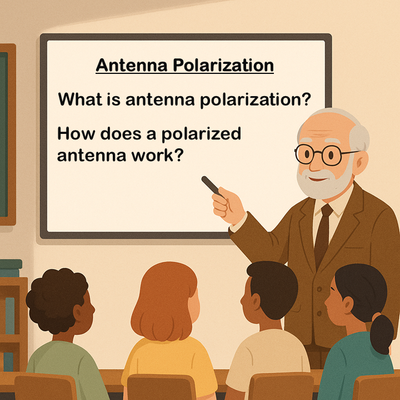Antenna Polarization Explained: Boosting Signal Quality in Real-World Conditions
Posted by Gordon Reed on 28th Jul 2025
In wireless communications, antenna polarization is a key factor that directly affects signal strength, reliability, and overall performance. Polarization refers to the orientation of the electric field of a radio wave, which must align between transmitting and receiving antennas to avoid severe signal degradation. In real-world environments, factors like reflections, mobility, and obstacles can alter or weaken signals when polarization isn’t considered.
At AntennaGear, we engineer antennas that are optimized for the demands of modern IoT, M2M, and 5G networks, ensuring that polarization is working for you, not against you.
What Is Antenna Polarization?
Antenna polarization describes the direction in which the electric field of a signal is oriented as it propagates. The most common polarization types are:
- Linear Polarization:
This includes vertical or horizontal orientations. A vertically polarized antenna must receive signals from another vertically polarized antenna to achieve minimal signal loss. - Slant Polarization:
A variation of linear polarization set at an angle (often 45°), offering better performance when exact alignment isn’t possible. - Circular Polarization:
Uses a rotating electric field to cover both left-hand (LHCP) and right-hand (RHCP) orientations, reducing the effects of signal reflections and multipath interference.
Choosing the correct polarization is not only about performance, but it can also be the difference between a strong connection and almost no signal.
Why Polarization Matters for Signal Quality
When transmitting and receiving antennas are not aligned in polarization, a phenomenon called polarization mismatch loss occurs. This can lead to signal loss of up to 20 dB, which is substantial enough to cripple data throughput or drop connections entirely.
High-frequency bands like 5 GHz, LTE-Advanced, and 5G are particularly sensitive to polarization mismatches due to their shorter wavelengths. Additionally, reflections off surfaces like glass, water, or metal can cause the signal’s polarization to shift, creating inconsistencies in coverage and throughput.
Polarization and Real-World Scenarios
Urban Environments
Dense cityscapes create a variety of reflective surfaces, leading to multipath propagation where the same signal arrives at the antenna with different polarizations and delays. Using cross-polarized or circularly polarized antennas can reduce signal fading in these conditions.
Rural and Line-of-Sight Installations
In open environments, maintaining polarization alignment is easier since there are fewer reflective obstacles. Directional antennas like Yagi or panel designs can benefit from linear polarization when correctly aligned.
Mobile and Vehicular Applications
Vehicles change orientation constantly, which can create polarization mismatches with stationary infrastructure. For these cases, antennas with circular or dual polarization ensure reliable connectivity.
IoT and Industrial Applications
Factories, warehouses, and utility infrastructure are filled with metal surfaces that distort signals. Cross-polarized antennas allow MIMO-enabled devices to mitigate these effects for stable performance.
Cross-Polarized and Dual-Polarized Antennas
Cross-polarized (X-pol) antennas combine two perpendicular linear polarizations, often at ±45°. This design is critical for modern MIMO (Multiple Input, Multiple Output) systems, which rely on multiple signal paths to increase data capacity and resilience.
Dual-polarized antennas are especially valuable in 5G deployments and environments where device orientation is unpredictable. AntennaGear’s X-pol solutions are designed with optimized port isolation and low PIM (Passive Intermodulation), ensuring peak performance even in challenging environments.
How to Choose the Right Polarization for Your Application
Selecting the right antenna polarization depends on several factors:
- Device Orientation: If your equipment will always remain fixed, linear polarization can provide maximum gain.
- Mobility: For moving assets like vehicles or drones, circular polarization often provides more stable connectivity.
- Environmental Conditions: Areas with heavy multipath interference benefit from cross-polarized or circular antennas.
AntennaGear offers solutions tailored to these needs, ensuring your network remains reliable regardless of conditions.
AntennaGear Solutions
Our product lineup includes a wide range of antennas designed with optimized polarization for specific use cases:
- Cross-Polarized Antennas engineered for 4G/5G MIMO performance.
What This Means for You
Antenna polarization can be the silent factor that makes or breaks your wireless connection. Whether you’re battling multipath interference in urban areas or seeking maximum throughput for a 5G application, choosing the right polarization is essential.
Explore AntennaGear’s antenna products to find solutions that ensure your network performs at its highest potential—even in challenging real-world conditions.

